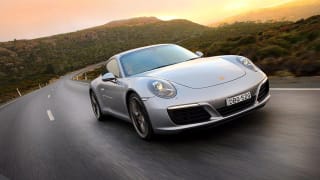
Porsche 911 Carrera S 2016 review
There is a button in the latest Porsche 911 that changes the world. It has the ability to transform...
Browse over 9,000 car reviews
Damien Reid road tests and reviews the 2016 Jaguar F-Type SVR with specs, fuel consumption and verdict at its international launch in Spain.
Jaguar has fired a clear warning shot across the bow of the Germans' go-fast operations with its fastest F-Type yet, the SVR.
The SVR, launched at the Motorland Aragon racetrack in Spain, is a coming of age for Jaguar Land Rover's Special Vehicle Operations, which for the past two years has been in the shadows of the JLR empire.
Until now, SVO has worked behind the scenes on the limited build Project 7 Jaguar roadster as well as the Range Rover Autobiography. The F-Type SVR event was its first stand-alone launch away from the mainstream range.
With a starting price just under $300,000, the F-Type SVR is the fastest volume production Jaguar yet.
Based on the F-Type R all-wheel drive, the SVR has been on a diet, shedding up to 50kg.
Its supercharged 5.0-litre V8 has been bumped up to 423kW/700Nm, an extra 8kW and 20Nm.
This equates to a claimed 3.7-second sprint from rest to 100km/h and a top speed of 322km/h for the coupe. The convertible matches it to 100km/h and reaches 314km/h.
It recalls the soundtrack of a big, lazy American V8.
Those acceleration claims make it two-tenths quicker than the Mercedes C63 and BMW M4 in the run to 100km/h, while the top speed is much higher than the 250km/h (restricted) for the BMW and 290km/h for the AMG.
Using the Project 7 as inspiration, the F-Type SVR features the same engine calibration mods and similar front aero enhancements, including the bonnet vents and enlarged air intakes in the front bumper to accommodate the revised charged air coolers.
It breathes easier thanks to a lightweight exhaust of titanium and Inconel, a nickel alloy that resists extreme heat. Using the alloy, Jaguar shaved 16kg from the car, halved the exhaust wall thickness to 0.6mm and reduced back pressure.
New titanium valves provide arguably the best part about the car, an outstanding exhaust note.
Once the Dynamic mode is selected to open the valves, lifting off the throttle on overrun rewards with a series of rapid-fire pops and crackles, even while idling through towns.
It recalls the soundtrack of a big, lazy American V8 that turns into a NASCAR-like roar with a sharp stab of the throttle.
On the track in full Dynamic mode the SVR was allowed to stretch its legs and the speedo on the back straight reached 288km/h.
Compared to the F-Type R, the SVR is 25kg lighter. Add a carbon-fibre roof and carbon ceramic brakes and that saving doubles to 50kg.
The extra weight of the 10mm wider Pirelli P Zero tyres is offset by a 13.8kg saving from new forged alloy wheels. The rubber, combined with the 380mm front and 370mm rear ceramic discs, provides phenomenal grip and stopping power on the open road.
The extra grip also comes courtesy of the aero tweaks that comprise wider front guards with extraction vents behind the front wheels to reduce lift, a new front valance and undertray from Project 7 that channels air under the car to a new rear diffuser and an active carbon-fibre wing.
The rear wing is a bit over the top from a styling point of view but it's functional. It deploys at 100km/h on the convertible and 112km/h on the coupe, reducing both drag and lift — by 7.5 per cent and 15 per cent respectively compared to the F-Type R.
On the track in full Dynamic mode — which transfers more drive to the rear wheels — the SVR was allowed to stretch its legs and the speedo on the back straight reached 288km/h.
That it could do it twice was an achievement though I wasn't confident of a third lap — even with the large carbon ceramic brakes fitted, the pedal went to the floor after two laps accompanied by dash alarms warning of overheating brakes.
Admittedly, that was an extreme test of the car's capabilities under race conditions but not something you'd expect on a top-notch performance car.
During nearly four hours of spirited, open-road driving on the same day there was never a hint of brake fade. The eight-speed auto has been remapped to provide quicker changes but the consensus is that with such performance, a double-clutch box would sharpen its responses even more — perhaps that's a prospect for the facelifted update.
| Vehicle | Specs | Price* | |
|---|---|---|---|
| R | 5.0L, PULP, 8 SP AUTO | $96,800 – 111,210 | 2016 Jaguar F-Type 2016 R Pricing and Specs |
| R | 5.0L, PULP, 8 SP AUTO | $98,340 – 113,080 | 2016 Jaguar F-Type 2016 R Pricing and Specs |
| V6 S | 3.0L, PULP, 8 SP AUTO | $66,660 – 76,670 | 2016 Jaguar F-Type 2016 V6 S Pricing and Specs |
| V6 S AWD | 3.0L, PULP, 8 SP AUTO | $68,750 – 78,980 | 2016 Jaguar F-Type 2016 V6 S AWD Pricing and Specs |
$92,730
Lowest price, based on third party pricing data